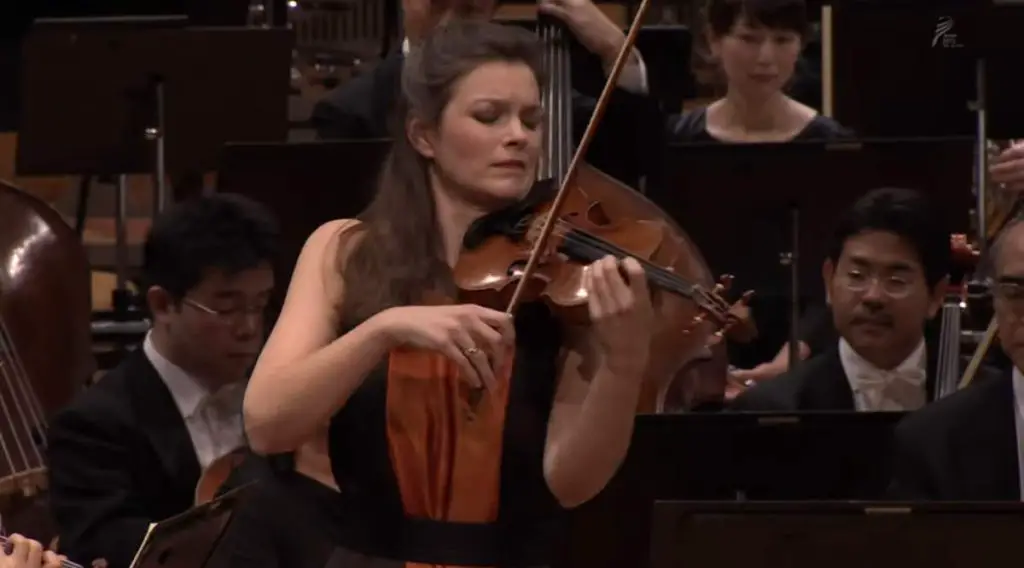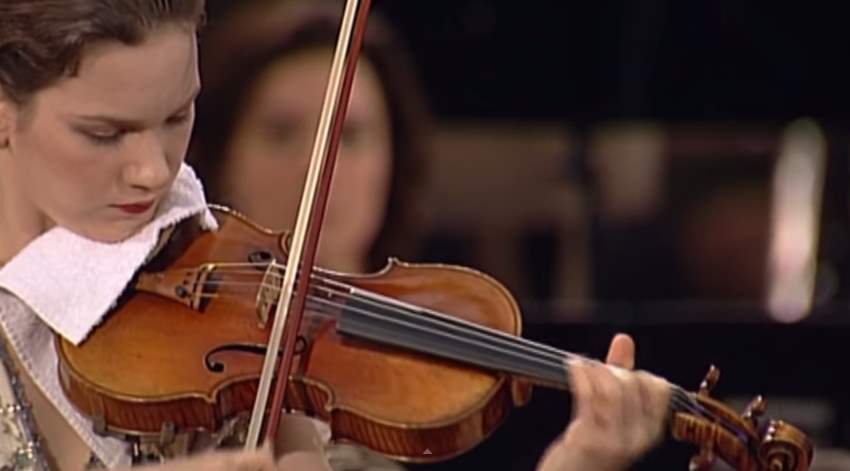Accompanied by the Orchestre Philharmonique de l’ORTF (today the Orchestre Philharmonique de Radio France), legendary violinist of the 20th century, Yehudi Menuhin performs Wolfgang Amadeus Mozart’s Violin Concerto No. 3 in G major, K. 216. Menuhin also conducts the orchestra. This performance was recorded at the Salle Pleyel, Paris, in 1967.
Wolfgang Amadeus Mozart’s Violin Concerto No. 3
Mozart’s Violin Concerto No. 3 in G major, K. 216, holds a special place in the classical music repertoire, embodying the elegance, vivacity, and depth that Wolfgang Amadeus Mozart is celebrated for. Composed in 1775, when Mozart was merely 19 years old, this concerto reflects both the youthful exuberance of its composer and the sophistication of his musical ideas, a testament to his genius even at such a young age.
This concerto, also known by the nickname “Strassburg” (in a letter to his father, Mozart called it the “Straßburg-Concert”) for a melody in the third movement reminiscent of a popular tune of the time associated with the city of Strasbourg, showcases Mozart’s unparalleled ability to blend technical virtuosity with emotional depth. The work is characterized by its lyrical melodies, intricate interplay between the solo violin and the orchestra, and a harmonic language that, while rooted in the classical tradition, hints at the emotive power Mozart would continue to explore in his later works.
Mozart’s approach to the concerto form in this piece is particularly noteworthy. He moves beyond the traditional roles assigned to the soloist and the orchestra, engaging them in a dialogue that feels both intimate and dynamic. This interaction allows for a more expressive exchange of musical ideas, elevating the concerto from a mere virtuosic display to a more profound communicative act.
The choice of G major as the key for this concerto also deserves attention. In the classical period, different keys were often associated with specific emotional characters. G major, with its bright and open sound, was particularly well-suited to the youthful and optimistic qualities that permeate the concerto. It allows for a piece of music that is at once accessible and deeply expressive, capable of capturing the listener’s imagination from the first notes.
Despite being composed early in his career, Mozart’s Violin Concerto No. 3 is a mature work that foreshadows the depth and breadth of his musical genius. Its enduring popularity among both musicians and audiences attests to its beauty, its technical challenges, and its expressive range. It remains a cornerstone of the violin concerto repertoire, celebrated for its melodic invention, structural elegance, and the balance it strikes between the soloist and the ensemble, embodying the spirit of the classical era at its most refined.
As with many of Mozart’s compositions, this concerto is not just a display of musical craftsmanship but also an invitation to explore the broader emotional and aesthetic landscapes of the classical era. It serves as a reminder of the timeless nature of Mozart’s music, which continues to inspire and move listeners more than two centuries after its creation.
Movements
1. Allegro
The first movement of Mozart’s Violin Concerto No. 3 in G major, K. 216, marked as Allegro, is a sparkling example of classical grace and precision, showcasing Mozart’s ingenuity and the solo violin’s expressive potential within the concerto form. This movement follows the classical sonata-allegro structure, which is characterized by an exposition, development, and recapitulation, offering a clear, balanced framework that Mozart both adheres to and innovatively manipulates to highlight the violin’s lyrical and virtuosic capabilities.
The exposition introduces two main themes, starting with the orchestra that sets the stage with a bright and inviting opening theme in G major. This section is not just a mere preamble but a declaration of the movement’s character-elegant, joyful, and vivacious. When the solo violin enters, it takes up the orchestral themes, expanding and embellishing them with a light, agile touch that demonstrates both the technical prowess required of the performer and the melodic beauty of the music.
Mozart’s development section ventures into more harmonically adventurous territory, exploring minor keys and offering a contrast to the exposition’s sunny disposition. Here, the solo violin engages in a more introspective dialogue with the orchestra, weaving through shifting harmonies and textures. This section showcases Mozart’s skill in thematic development and his ability to create drama and tension within the classical framework, all while maintaining a sense of coherence and continuity.
The recapitulation brings back the main themes from the exposition, now colored by the journey of the development. The solo violin reasserts the primary themes with renewed vigor, leading to a cadenza (a section where the soloist performs alone, typically improvising on themes heard earlier in the movement). Mozart’s cadenzas, when specified, are moments of pure virtuosity and creativity, allowing the soloist to showcase their technical skills and interpretive depth. The movement concludes with a spirited coda that reaffirms the G major tonality and the joyful character of the opening, ending on a note of triumph and exhilaration.
Throughout this movement, Mozart balances the solo violin’s virtuosity with its capacity for lyrical expression, creating a dialogue with the orchestra that is both competitive and cooperative. The interplay between the soloist and the ensemble is seamless and fluid, illustrating Mozart’s masterful orchestration and his nuanced understanding of the violin’s capabilities. This movement not only sets the tone for the concerto but also exemplifies the elegance, wit, and emotional depth that characterize Mozart’s instrumental music.
2. Adagio
The second movement of Mozart’s Violin Concerto No. 3 in G major, K. 216, marked as Adagio, stands in poignant contrast to the vivacity and brilliance of the first movement, embodying a serene, lyrical beauty that showcases Mozart’s ability to convey profound emotional depth through simplicity and elegance. Set in the key of C major, this movement provides a tranquil interlude that speaks to the composer’s gift for melodic invention and expressive nuance.
In this Adagio, the solo violin emerges not as a virtuosic protagonist but as a tender, reflective voice that sings above a subdued orchestral accompaniment. The movement opens with a gentle orchestral introduction that sets a mood of contemplative calm, creating a canvas upon which the solo violin can paint its delicate, expressive lines. The solo part is lyrical and expansive, allowing the violinist to explore a wide range of expressive nuances, from tender intimacy to poignant longing, within the framework of a relatively restrained dynamic range.
The structure of the movement is simple and straightforward, eschewing the complexity of the first movement’s sonata-allegro form in favor of a more direct emotional appeal. The melody, with its graceful arcs and tender inflections, invites listeners into a space of introspection and emotional vulnerability, showcasing Mozart’s skill in creating music that speaks directly to the human heart.
Mozart’s orchestration in this movement is notably restrained, with the orchestra providing a warm, supportive backdrop that enhances the solo violin’s lyrical voice without ever overshadowing it. The use of dynamics and texture in the orchestration serves to highlight the soloist’s expressive range, creating moments of breathtaking beauty and depth that emerge from the simplest of musical materials.
The second movement’s serene beauty offers a moment of repose and reflection between the energetic outer movements, contributing to the overall balance and architecture of the concerto. It is a testament to Mozart’s genius that he could imbue such a short, simple movement with such a wealth of emotion and beauty, making it one of the most cherished moments in the violin concerto repertoire.
3. Rondeau: Allegro
The third movement of Mozart’s Violin Concerto No. 3 in G major, K. 216, marked as Rondeau: Allegro, is a spirited and engaging conclusion to the concerto that combines the elegance and wit characteristic of Mozart’s compositions with a lively dance form. This movement is structured as a rondo, a form that features a recurring main theme (the “A” section) that alternates with contrasting sections (the “B” and “C” sections, etc.). This structure allows for a variety of musical ideas to be presented and revisited, creating a sense of unity and diversity throughout the movement.
The movement begins with the orchestra introducing the main rondo theme, a cheerful and catchy melody that sets the tone for the playful and vivacious character of the movement. When the solo violin enters, it takes up this theme, embellishing and expanding it with virtuosic flourishes and expressive nuances. The rondo theme serves as a musical anchor throughout the movement, returning after each contrasting section to reassert the joyful mood of the opening.
The contrasting sections introduce new themes and explore different musical characters and textures. One of the most notable features of this movement is the inclusion of a section known as the “Strassburg” theme, a popular tune of the time that Mozart incorporated into the rondo structure. This melody, with its folk-like character and rhythmic vitality, adds a unique color and charm to the movement, showcasing Mozart’s ability to blend high art with popular musical elements.
Throughout the movement, the interplay between the solo violin and the orchestra is lively and dynamic, with the solo part weaving in and out of the orchestral texture. The virtuosity demanded of the soloist is more pronounced in this movement, with rapid passages, intricate runs, and lively rhythms that require technical precision and expressive agility. Yet, even amid the virtuosic display, Mozart’s music maintains a sense of elegance and balance, never sacrificing musicality for mere technical prowess.
The rondo form, with its repetitive structure, lends itself to a sense of playful anticipation as the listener awaits the return of the main theme. Mozart exploits this to create a movement that is both cohesive and varied, culminating in a spirited coda that brings the concerto to a triumphant and exhilarating close.
Sources
- Violin Concerto No. 3 (Mozart) on Wikipedia
- Violin Concerto No. 3 in G major, K.216 (Mozart, Wolfgang Amadeus) on the International Music Score Library Project website


